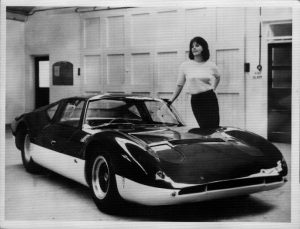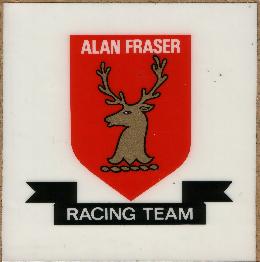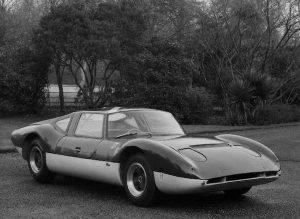STEVE HOLE TELLS THE STORY OF THE FRASER GT
Alan Fraser had a very interesting automotive story within motorsport and the specialist car industry. Although his parents were Scottish, Alan was born in Hildenborough, Kent in 1930.
He earned the nickname ‘the little hurricane’ due to his fast and carefree driving style. It was 1953, when the 23-year-old Fraser started the Alan Fraser Racing team based at Mountains Garage, Hildenborough, right by the side of the A21. His team logo was always a Stag emblem, a tip of the hat to his Scottish ancestry.
By the time the Hillman Imp arrived in 1963, Fraser had been racing Sunbeam Rapiers for about a year and later rallied them, too, although the arrival of the Lotus Cortina killed that off, really. Although he never classed himself as a racing driver, as he said himself, he always liked to have the odd race himself and ‘have a bit of a go’. He was also president of the Brighton & Hove Motor Club.
In the summer of 1964, he entered a couple of race meetings for Rosemary Smith to drive a standard Hillman Imp. From October that year, he really began to focus his attention on the Imp, particularly its 998cc engine, for which he also offered tuning services.
He was convinced that an Imp could beat the Cooper S on track and in rallies and an Alan Fraser Racing Imp won its first event in August 1964.

Although he concentrated on the Imp, Alan managed to win the Brighton Speed Trials outright in September 1965 in one of his Sunbeam Tigers.
Fraser Imps became renowned. There was nothing scientific about his approach. In reality, he strengthened the swinging arms and used Imp Van driveshafts as they were designed to be able to take more punishment and he also fitted stronger springs and adjustable Armstrong dampers. Meanwhile, up at the front, the pivot arm was lowered so as to make the front wheels more upright.
The team won nine races in 1965.
Aside from revised geometry and adjustable suspension, his cars were usually otherwise in standard guise. He did later add a rear anti-roll bar from mid-1966.
Fraser’s number one driver was Roy Calcutt teamed with ex-Rootes works driver, Bernard Unett, while chief mechanic, Norman Winn built a 90bhp 998cc engine in 1966, which made the team even more successful aided by gifted rallycross engineer, Peter Harper. 28-year-old Calcutt was an ex-Policeman and became Fraser’s team manager.
Other drivers included artist, Jacqui Smith and PR man Nick Brittan, like Unett an ex-Rootes driver. Brittan was a real character and wore many other hats from marathon rally pioneer, a TV producer, journalist and author. During his almost four-decade career in motorsport, he organised and directed a large number of rallies and long-distance marathon events. Along with Lotus’ Graham Arnold he developed the Lotus 51 single-seater roadcar ‘Flower Power’. He was also an excellent driver. Nick tragically took his own life in Australia in November 2006.
Fraser even became a manufacturer in his own right in early 1967, under the Alan Fraser Engineering banner, with a Tom Killeen-designed car, with monocoque construction (formerly known as the Killeen K9), that he called the Fraser Le Mans GT. The car was unveiled at the Racing Car Show in January 1967 where its direct rival was the Costin-Nathan Imp.
Killeen was an under-rated genius and one who also had involvement with motorcycles and the kitcar world. He always claimed that he was first to develop a monocoque for automotive use, definitely before Colin Chapman. His K9 was a successor to his K4 and K9 designs. Incidentally, by day he was employed as a designer at Jensen Motors in West Bromwich.
The Fraser was loosely based around FIA Group 6 rules and his intention was long distance sportscar racing, with Le Mans a target. He had got to know Tom Killeen via another project they’d worked on for Rootes together, while he was having great success with his Imps including a feared 1150cc engine.
Although Rootes Group were big on the rallying scene and claimed to have a work race team, they didn’t. They relied on Alan Fraser Engineering to represent them in circuit racing. They, therefore, agreed to help fund Fraser’s tilt at Le Mans in June 1967 and even started to develop a 2-litre V8 Imp unit (basically two standard 998s ‘stitched’ together on a common crank.
It featured a lot of Imp parts unsurprisingly with a beam axle front set up, de Dion rear with parallel trailing arms located by a Watts linkage. Unusually, geometry front and rear were identical. Standard power came from a Fraser 1150cc Imp engine.
When Rootes Group was taken over by Chrysler, this immediately killed the proposed Imp V8 engine, while although Fraser was struggling to complete the Le Mans GT, it also acted as the final nail in its coffin. Sadly, the Fraser GT, despite having immense promise never raced and was quietly dropped.
Alan Fraser died, aged 80, in October 2010.











